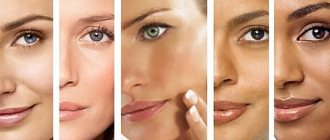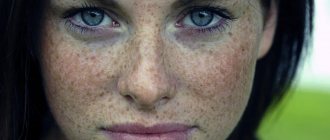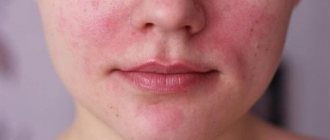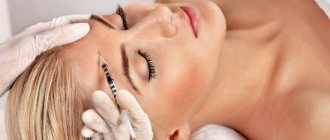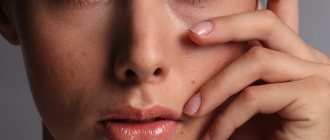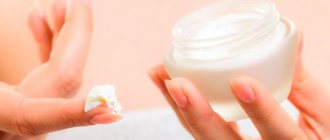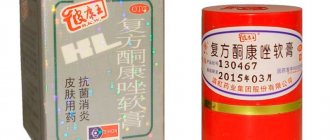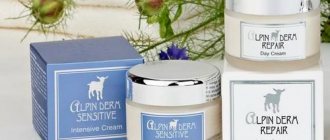Melasma
is a common pigmentation disorder that causes brown or gray patches to appear on the skin, primarily on the face. The most common areas for melasma to appear on the face are:
- nose;
- forehead;
- cheeks;
- upper lip.
Melasma can appear on other areas of the body, especially when exposed to large amounts of sunlight. These areas may include:
- forearms;
- neck;
- shoulders.
According to the American Academy of Dermatology, only 10% of all cases of melasma occur in men. Dark skinned women and pregnant women are at greater risk of developing melasma.
What is it and features
Chloasma (ICD10 code – L81.1) is focal hyperpigmentation on the skin. The disorder does not have specific boundaries of manifestation, but is localized on the face. The disease is represented by brown or light brown spots. After complications, the pigment spot can grow. The pigment serves as the basis for protecting fabrics from ultraviolet radiation.
Under the influence of sunlight, chloasma becomes bright. The color of the spot becomes more intense after visiting a solarium, which is accompanied by an unpleasant cosmetic defect.
In most cases, chloasma appears on the face (cheeks, forehead). Brown spots have jagged, ragged edges. In parallel with this, a darkening of the halo around the nipples of the mammary glands is observed. The genital area is susceptible to a benign disease. Dark stripes on the abdomen are often found.
Red, but not freckled
“If you see a red-haired and freckled boy, then he is from the Weasley family,” Draco Malfoy said contemptuously to Harry Potter. Both Ron, Fred, and George were indeed distinguished by wild freckles, but not all owners of fiery hair color can boast of freckles.
In addition, freckles can appear on the face and shoulders of blondes and even brunettes. According to scientists, the Mc1r gene is responsible for the tendency to freckle - it regulates the production of melanin in humans.
Scientists were able to discover another gene associated with the active production of melanin pigment and the appearance of freckles - however, it does not work alone, but “in a team”. This gene is called IRF4, and its main function is to regulate the production of proteins, which, in turn, stimulate the production of interferon proteins (they are produced in response to the invasion of viruses into the body and thus ensure the functioning of the immune system). You can read the full study in the journal Cell.
During the work, the researchers analyzed the genetic material of 95,085 residents of Iceland: as a rule, they have fair skin, blue or gray eyes and brown hair. Geneticists analyzed 16,280 sections of DNA surrounding the IRF4 gene in different people. As a result, it turned out that if IRF4 is surrounded by certain regions of the gene, which is most surprising, they are non-coding, that is, they are not responsible for the production of any protein, then this leads to the appearance on the skin of freckles and other genetically linked features: brown hair, fair skin, blue eyes and increased sensitivity to sunlight.
“Investigating the biological processes and molecular mechanisms that are associated with variation in these poorly understood regions of the genome is a very challenging part of our work. This is one of those rare cases when scientists were able to link a non-coding region of the genome with a functional mechanism,” comments lead author William Pavan.
Causes and symptoms
Chloasma on the face has specific causes and severe symptoms. The fundamental reason for its development is hormonal imbalance. The disorder is common in pregnant women. Let's analyze a number of factors that influence the formation of the disease:
- pregnancy;
- the presence of changes in the body (puberty, menstrual pauses, senile criteria);
- development of liver and bile duct disease;
- prolonged exposure to the sun (ultraviolet exposure);
- malaria;
- tuberculosis;
- influence of chemicals on the skin;
- negative effects of cosmetic ingredients.
Pigmentation is accompanied by the formation of small spots. The color of such skin lesions is represented by brown and yellow colors. The edges of the spots are uneven and tend to merge. The person does not experience pain or discomfort.
Causes of appearance on the back, face
Modern medicine still cannot give a clear answer about the reasons that provoke the appearance of melasma. But there are suggestions that such a violation may be facilitated by:
- hormonal imbalance, including endocrine diseases (which is why the problem is more common in women);
- problems with the functionality of the kidneys, the entire urinary system and the liver with the gallbladder, occurring in a chronic form with frequent exacerbations;
- long-term use of certain medications (usually steroids);
- cosmetics not selected according to skin type;
- ovarian dysfunction.
Of the external factors, only direct exposure to sunlight stands out, but we are talking specifically about a long period of exposure to the sun or in a solarium.
Melasma and chloasma - what's the difference?
Melasma and chloasma are synonymous skin diseases. The approach to treating the symptoms of these ailments is absolutely the same. There is no consolidated opinion in the medical community regarding the uniformity of pathology identification. Doctors have developed several approaches to understanding these disorders:
- Clear reasons for the pigmentation process. Chloasma is a consequence of hormonal imbalances, a disease of the human reproductive system and liver disorders. Melasma is characterized by disturbances in the functioning of the gastrointestinal tract.
- Identity of diseases. This direction of classification is especially common in Western countries. Qualified physicians identify the disease (chloasma = melasma = melasma) that occurs during pregnancy. In medical theory, these names are considered and treated as identical.
Methods for diagnosing the disease
The process of diagnosing age spots is carried out by a professional dermatologist/cosmetologist. A specialized doctor will be able to characterize chloasma on the face based on the patient’s appearance. This is followed by a survey of the sick person regarding cosmetic surgery. As a result of the survey, the nature of the development of the disease (congenital/post-inflammatory) is clarified.
To deeply analyze the pathology, you should resort to the methods of dermatoscopy and siascopy. Using these mechanisms, you can obtain an optimal treatment regimen. After this, diagnostic measures are prescribed, which are aimed at examining the intestines and stomach. FGS, analysis for dysbacteriosis.
Attention should be paid to the condition of the liver and thyroid gland. Ultrasound is used to examine the human abdomen. Women are advised to visit a gynecologist.
Types and features of localization
Chloasmas, which are located next to each other, are consolidated into homogeneous spots. Depending on the level of affected areas, the following types of disease are distinguished:
- centrofascial – observed on a person’s lips, forehead, nose;
- molar - pigmentation concerns the cheeks, cheekbones, sides of the nose;
- mandibular localization - the disorder concerns damage to the skin in the area of the lower jaw.
The spots do not become inflamed as they develop. The person does not experience severe itching or burning sensation. Often pregnant women are faced with a brown stripe on their stomach or back. After childbirth, the formation disappears. Treatment in this case is not required.
Hyperpigmentation can affect the skin of the mammary glands (including the nipple area). The disorder affects the torso, femoral surface and collar area of a person.
Review
The first time I developed chloasma was about 5 years ago after a strong passion for tanning. Then it intensified during pregnancy, and after childbirth it remained the same. I tried a huge number of ointments and creams, folk remedies. There was a noticeable improvement, but after a while the spots darkened again.
So I suffered until a friend recommended a good dermatocosmetologist. He selected me a medicinal cream with kojic acid, lemon and cucumber extracts “MICROCELLULAIRE” and prescribed vitamins B and C. I also had a medium peeling with glycolic acid, 3 procedures.
There are several barely noticeable spots left on the face that are easily hidden under foundation. Now I always use sunscreen and plan to undergo peeling procedures once a year.
Albina Voevodina, 38 years old.
Treatment methods
Chloasma can be cured using many methods. The doctor will recommend hardware procedures or topical medications. You can try to remove tumors using folk remedies, but the effect can be unpredictable.
Hardware procedures
Salon treatments are effective tools for eliminating chloasma.
- Mesotherapy. A bleaching agent is injected into the skin. The procedure is implemented during the quarter once every 7 days. The effect is suitable for people with thin and inflamed skin.
- Phototherapy. Special light radiation is based on the generation of specific light rays that affect the destruction of melanin.
- Cryotherapy. Doctors use liquid nitrogen to target damaged areas of the skin. The pigmented area begins to peel off over time, removing the brown spots.
- Laser grinding. The affected areas are removed using an anesthetic.
- Ultrasonic peeling. The result is achieved after 10 sessions per year using a functional device. Removal of stains is carried out without anesthesia.
- Chemical peeling. A special solution of acids has a unique effect. Connection options are selected by a cosmetologist.
- Dermabrasion. The procedure is based on mechanical peeling using special crystals (anesthesia is required). After removing the top layers of skin, a healing ointment is applied.
Pharmacy products
Special preparations for pigmentation must be of high quality. Cheap analogues are not recommended. The medications should include the following elements:
- ascorbic acid. The substance carefully removes pigments in the upper layers of the skin. Vitamin C helps even out color and create healthy skin;
- White clay. A natural remedy deeply cleanses the skin, removing age spots;
- plant extracts. Chamomile, lemon, celandine, and yarrow are excellent. Juices effectively relieve tension and inflammation;
- kojic acid. The compound blocks melanin, preventing the formation of age spots;
- zinc lactate. The substance provokes skin regeneration and evens out complexion;
- melanosin. The medication perfectly fights excess melanin (available form);
- titanium dioxide The toxic substance is actively used among cosmetics;
- green tea. A high-quality antioxidant prevents the development of pigment structures;
- synthomycin - an element that maximizes skin restoration and relieves inflammatory processes;
- azelaic acid. The medicine is indispensable for acne, the spread of age spots on the human face.
Before using medications, skin sensitivity tests must be performed. Medicines are prescribed by a certified dermatologist/cosmetologist. Concentrated formulations can cause complications and additional disorders. Attention should be paid to the composition of the drugs.
Cosmetic preparations
The use of special creams and ointments should become the daily norm for skin pigmentation. In the morning, it is rational to use a compound to protect against sun rays (25 SPF), and at night - a moisturizing mixture (medicinal approach).
- “Lakshma Maxi” is an American product that does not cause allergies and does an excellent job of lightening the body.
- “Expert White” is a Belarusian development that provokes the generation of melanin at the cellular level.
- “White Plus Renew Night Cream” - Korean cream perfectly moisturizes the skin.
- “Performance Anti-taches by Chanel” - a development suitable for mature skin.
- “Depigmenting Cream” - a French product that has a pronounced whitening spectrum and a regenerating effect. You should remove stains from your skin in stages.
Traditional methods of treatment
A huge number of drugs from pharmacies have side effects. By using a folk recipe, you can save money and maximize successful results. You can prepare ointments at home:
- lemon cream. Vitamin C effectively affects the skin whitening process without deteriorating human health. Citrus is crushed to a porridge state and mixed with 2 tbsp. l. honey The mixture is applied to the affected areas of the skin. Treatment can be done at home;
- panthenol "D" + essential oil. To do this, you will need 1 g of the drug and 5 drops of lemon oil. You need to add 5 drops of lavender, 1 g of chamomile extract and 0.5 mg of dandelion infusion. All ingredients are mixed until smooth. Stains should be removed under the supervision of a doctor;
- special ointment made from parsley and honey. The mixture allows you to get rid of pigments and normalize the condition of the skin. The size of the lesion does not matter to heal the skin;
- strawberries + black currants. The crushed ingredients are applied to the affected areas (30-40 minutes). After use, the residues are washed off with warm water. As a result, pigmentation will begin to disappear due to the saturation of the epithelium with beneficial vitamins (systemic therapy).
Types of melasma
The disorder in question in medicine has a rather complex classification. First, we distinguish the types of melasma by location:
- mandibular - visually detectable changes are noted in the lower part of the face, most often affecting the line of the mandibular arch;
- centrofascial - pronounced pigmentation is localized in the central part of the face, spots can be located anywhere, but do not affect the cheeks;
- painting - the problem occurs on the cheeks, and may partially affect the nose.
a) Malar melasma;
b) After treatment with TCA peeling The following type of melasma is determined by the form of the disease:
- persistent – the spots do not disappear completely, but periodically become significantly paler (the disease follows the principle of chronic pathologies “exacerbation/remission”);
- transient - once the causes or provoking factors are eliminated, the spots disappear without medical intervention.
But the main difference doctors make is the depth of damage to the dermis by melasma, because the choice of treatment regimen will depend on this.
Epidermal
This form of the disease is considered the mildest and is highly treatable. Excessive pigmentation occurs only in the epidermis - the outer, top layer of the skin. Often, therapeutic measures are reduced not to the use of medicines, but to the implementation of specific cosmetics and procedures.
Epidermal melasma is characterized by a light shade of the spot and its smooth contours.
Dermal
Pigment spots are dark in color and “blurred”. Not only the top layer of skin is affected, but also deeper ones - cosmetics and even aggressive whitening or cleansing procedures will not give the desired effect.
Dermal melasma is very difficult to treat and the sooner it begins, the greater the chance of success. At least partial – lightening of spots.
A) Dermal melasma; B) After a course of treatment with retinol peeling and photorejuvenation.
Mixed
This is also a complex form of the disease, since both light and dark spots may be present on parts of the body. Melasma of mixed type is difficult to diagnose and requires differentiation from cutaneous lymphoma, non-melanoma cancer, and pseudoleukoderma.
Properly selected therapy can only put the disease into remission, but does not lead to complete recovery.
Watch this video about laser treatment of melasma:
Danger and possible consequences
Treatment of long-standing chloasma on the body or face should be systemic. The skin disease has no complications and affects the deterioration of human health. The main difficulty is the presence of forms that cannot be treated. The most effective way to protect against the disorder is to follow the rules of sunbathing and staying outside on hot days. When going for a walk, it is necessary to reduce the time a person spends at high temperatures. Pre-treat the skin with a special cream or lotion.
Prevention of chloasma lies in external manifestations. Avoid buying clothes that fit tightly to your body. The body's interaction with chemicals should also be minimized. These compounds contribute to the gradual erosion of epithelial layers. This is especially true for engine oil and gasoline.
Preventing a skin disorder is easier than treating it. The therapeutic effect is selected by qualified specialists. Control allows you to monitor the results and eliminate shortcomings.


